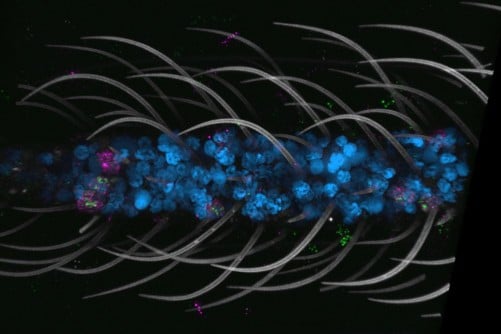Researchers at Rockefeller University have created the world’s first comprehensive cellular atlas of the Aedes aegypti mosquito, a species noted for transmitting numerous diseases, including dengue and Zika. This groundbreaking project, conducted in collaboration with experts globally, aims to enhance understanding of mosquito biology, potentially paving the way for novel strategies to combat these pests. The Aedes aegypti Mosquito Cell Atlas was recently published in the scientific journal Cell and is freely accessible to researchers and the public.
The atlas offers a detailed view of gene expression across every tissue in the mosquito, from its sensory antennae to its legs. Leslie Vosshall, head of the laboratory of neurogenetics and behavior at Rockefeller and a prominent researcher on Aedes aegypti, highlighted the significance of this achievement, stating, “This is a comprehensive snapshot of what every cell in the mosquito is doing as far as expressing genes.” Vosshall has dedicated nearly two decades to studying this species, and her team’s work has revealed previously unknown cell types and distinct genetic variations between male and female mosquitoes.
Insights into Mosquito Biology
The new dataset comprises over 367,000 nuclei from 19 types of mosquito tissues across various biological themes, including reproduction and viral infection. This extensive data collection utilized single-nucleus RNA sequencing (snRNA-seq), which is adept at capturing the biology of different insect cell types compared to traditional single-cell methods. According to Nadav Shai, the senior author of the study and a scientist at both Vosshall’s lab and the Howard Hughes Medical Institute, this dataset is expected to drive significant advancements in mosquito biology research.
Previous studies had largely focused on female mosquitoes, as they are the primary vectors for disease transmission, while male mosquitoes received less attention. This bias has now been addressed, with Vosshall noting the need for inclusivity in research. “So we wanted to be inclusive and fill in the gap,” she stated. The atlas not only documents the cellular structure of both male and female mosquitoes but also emphasizes the importance of their shared biology.
Key Discoveries and Future Directions
Among the critical findings is the discovery of 69 cell types categorized into 14 major cell groups, many of which had not been previously identified. Notably, the research revealed that mosquitoes possess polymodal sensory neurons capable of detecting various environmental stimuli. “These multifunctional chemoreceptors allow them to, among other things, detect sweetness and fresh water,” Shai explained. This capability is vital for both males and females, as it assists them in locating food sources and suitable environments for reproduction.
The study also explored dramatic changes in gene expression in female mosquitoes after blood feeding. The researchers observed that the glial cells in the brain, which make up less than 10% of mosquito brain cells, underwent significant shifts in gene expression at various intervals post-feeding. This finding suggests that glial cells play a crucial role not only in supporting neuronal function but also in influencing behavior.
Despite the evident morphological and behavioral differences between male and female mosquitoes, the research indicated that their cellular makeup is largely similar. “We were kind of expecting it to be a tale of two genomes, but that’s not what we found,” Vosshall noted. While small clusters of sex-specific cells exist, the majority of cells are fundamentally alike, suggesting that differences in behavior arise from variations in gene regulation rather than distinct cellular structures.
Looking ahead, Vosshall and her team plan to leverage this extensive dataset to further investigate the behaviors related to host seeking and environmental sensing in Aedes aegypti. “Different people in the lab are going to take it to different places,” Shai remarked, expressing optimism about the potential discoveries that could emerge from this open-access resource.
The ongoing collaboration among global scientists and the availability of this cellular atlas mark a significant advancement in mosquito research, offering new avenues for exploring the complexities of mosquito biology and potentially informing future public health strategies.







